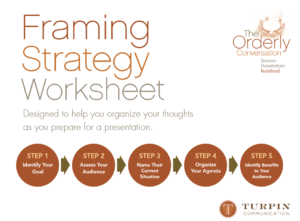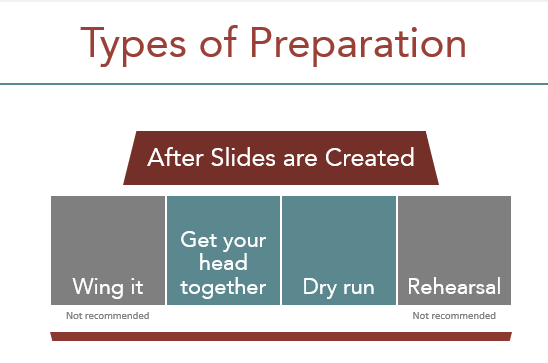
- Greg Owen-Boger Myths Debunked, Presentations
For some presenters, preparation is all about collecting data and turning it into PowerPoint slides. There’s more to effective, efficient preparation than that, though. It’s not that you won’t use slides. It’s that by creating slides right off the bat, you may skip steps intended to help you craft your content to meet the needs and perspectives of your audience.
Presentation Preparation Tips
We use a Framing Strategy Worksheet to help get the preparation process going. Using it will walk you through some often overlooked steps in preparing a presentation. You can download the tool for free.
Audience Analysis
When you skip the audience analysis step, you run the risk of presenting information that isn’t relevant or specific enough for the group of people you’re presenting to. Thinking carefully about them may lead you to realize a variety of factors, including
- This group already knows the foundational concepts, so those can be glossed over or skipped entirely.
- This is a mixed group with a varying degree of understanding and perhaps different emotional reactions to the content.
- This group is holding on to antiquated ideas that will have to be acknowledged and course-corrected.
- This is a group of senior executives, so keeping the presentation high-level will be necessary.
The Order of Things
In addition to analyzing the audience, consider how the information you’re presenting should be ordered. Along with the basic considerations like whether to organize chronologically or from most to least important, consider whether you should:
- Lead with the recommendation, and then support it with evidence.
- Present your research and then your recommendation.
In both situations, look at it from your audience’s point of view, not your own. If you’ve ever been asked to jump ahead or get to the point, you may want to lead with your recommendation. If your audience prefers to carefully consider each step in your thinking, begin with your research.
Framing
Once you’ve considered your audience and how you plan to deliver information, think about how you will begin the presentation. An agenda is important, but you also want to set context, clearly state your goal, and articulate the audience takeaways from the presentation. Your goal is to frame the conversation by providing a sense of direction, purpose, and a reason for your audience to participate.
Preparing Yourself
When your slides and other documentation are ready to go, what should you do to prepare yourself to present? Traditional presentation skills training would encourage you to rehearse. We disagree. Rehearsal leads to rote delivery or, worse, having a meltdown when things don’t go according to plan. Actors rehearse. As a business person, you need something more appropriate when preparing to give a presentation.
Let’s take a look at this graphic.
It shows a preparation continuum from left to right, from least controlled to most. As you can see, the two extremes are not recommended. Trusting yourself to wing it can lead to long, rambling, unfocused presentations that waste time. Rehearsal can lead to inflexible delivery and stifling the group interactions that are necessary for listener engagement and decision-making.
The two options in the middle are more appropriate for presentations that get business done.
- Getting your head together is about looking at the big picture and reminding yourself of how the content is organized. This allows you to think about the main points and how one point connects to the other.
- A dry run is about talking through the content. This is not about finding perfection (that’s closer to rehearsal). Dry runs are about finding trouble spots, thinking about various ways to explain things to build flexibility, and figuring out how much time you should devote to each section.
The option you choose to get yourself prepared to present will be unique to you. Just remember that at this stage, you aren’t trying to perfect your delivery. You’re trying to get comfortable enough with your plan to be concise and nimble during your presentation.
How do you normally prepare for a presentation? We would love to hear your thoughts. Also, remember to check our resource page for regular educational posts on topics like this and more.



